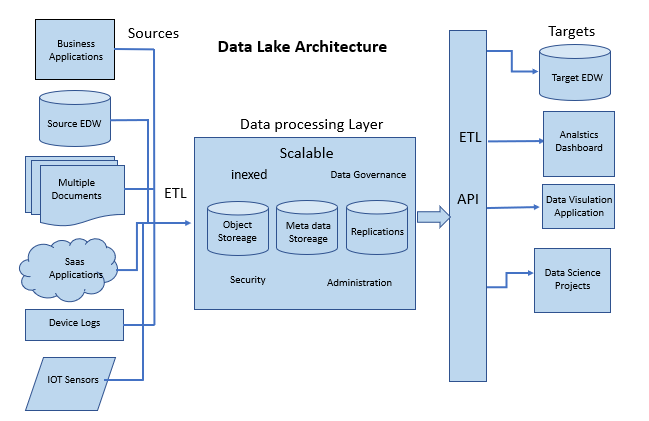摘要: Since its conception in October 2010 by James Dixon, data lake has undergone a myriad of developments and is now used globally by a lot of firms. To understand how a data lake works or what it can be used for, we must first understand what it means.

▲圖片標題(來源: BDAN)
A data lake is a storage space where large amounts of data can be stored in their raw formats, the type of data to be stored may be structured, semi-structured, or unstructured data. Data lakes may be used for data exploration, data analytics, and machine learning. Now that we know what a data lake is, we can go over what the data lake architecture is, and how it works.
Fundamentals of Data Lake Architecture
The data lake architecture is designed to ensure the return of the best possible result from the data storage unit. That said, there are several components in the architecture that make data lake functional.
Data ingestion and Data Storage
Data lake absorbs information from several sources such as databases, applications e.t.c, a data lake can also ingest data from a data warehouse. The main difference between a data lake and a data warehouse is that, unlike a data warehouse, a data lake does not need to convert or refine data before it can store it. The ingested data is stored in a limitless central storage unit where it is converted into open data formats, after which it is optimized for consumption.
Data Processing
After the conversion of the data into open data formats, it is prepared for consumption via various engineering routes called engineering pipelines. Depending on their scale footprints, the open data might need large scalable pipelines to be ready for data consumption. As an added advantage, large scalable pipelines have complex data organizing functions. Data processing engines such as Apache Spark and Apache Hive can be employed for desired performance and results.
Data Governance
In an organization, multiple personnel gain access to data. When this happens, it becomes necessary to control the security and pay attention to the consumption of data by unauthorized personnel.
One surefire way to tighten the security is to encrypt the information in the data lake. The data is stored in the cloud, therefore, the cloud providers distribute encryption keys to their clients. These keys give access to the data stored in the cloud, and only people with access to the encryption keys can access data stored in the data lake.
Data Discovery and Analysis
Before preparing the processed data for analysis and consumption, the information in the data lake needs to be expressed and translated. Data tagging techniques are used in this case, to organize and translate the data.
A domain-specific programming language, SQL, is normally utilized for the analysis of the data in a data lake, especially for business purposes. In addition, Open Database Connectivity (ODBC) and Java Database Connectivity (JDBC) drivers can be used to run third-party SQL clients.
轉貼自: BDAN
若喜歡本文,請關注我們的臉書 Please Like our Facebook Page: Big Data In Finance


留下你的回應
以訪客張貼回應